Law enforcement and intelligence agencies are always facing complex and constantly evolving crimes and incidents, which are multi-channel, having dynamic data sources from which evidences are acquired.
New technologies give rise to new crimes. Crime and criminal activities are getting advanced day by day, creating an urgent and constant need to upgrade the existing ways of policing.
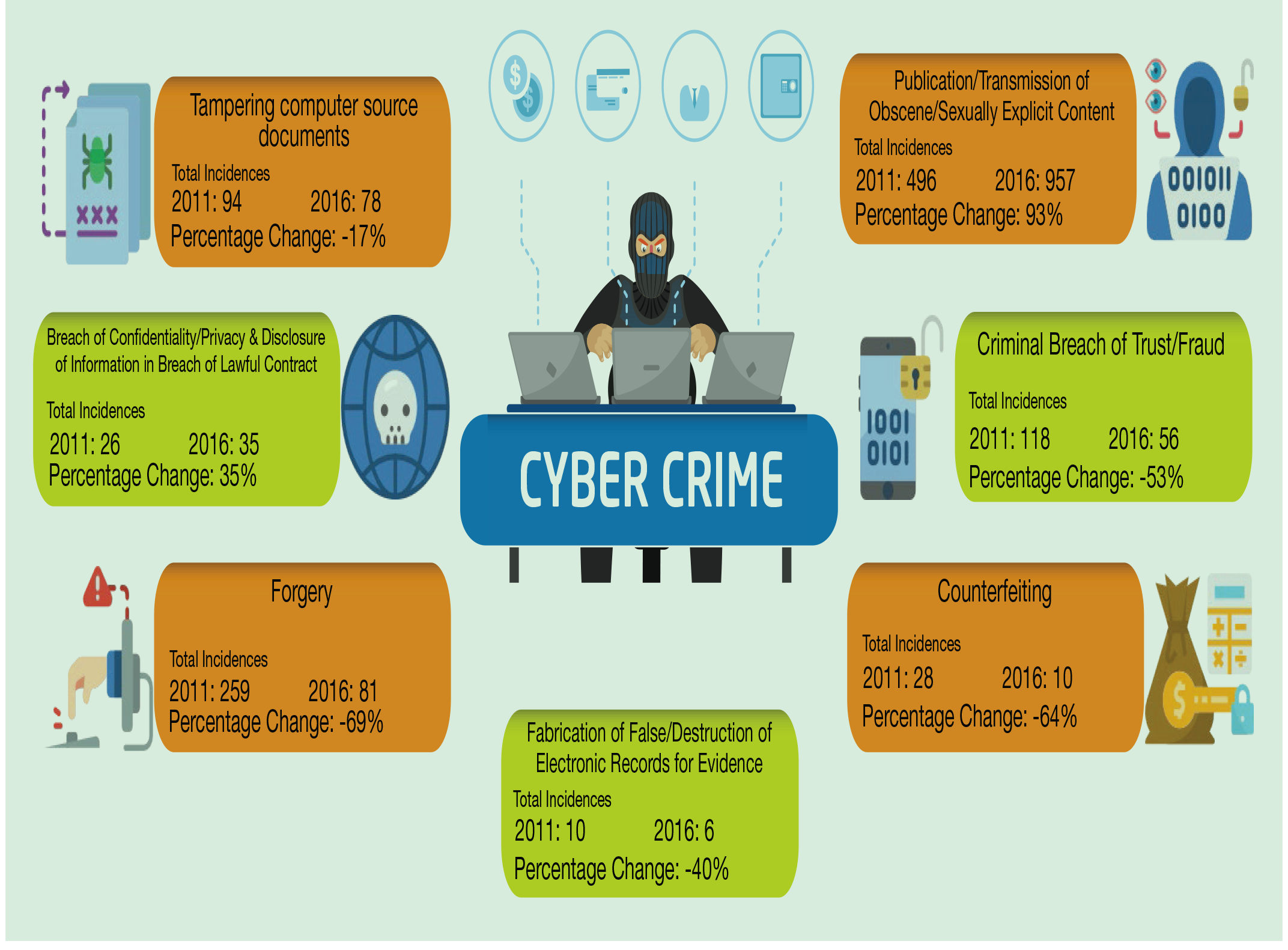
To decrease the rate of crime, to increase the rate of response and to improve the investigation, countries around the world have started moving towards the adoption of digital technologies such as mobile workforce, data collation, data analysis and multiple interaction channels for citizens.
 Advancement of crime & criminal activities is increasing day by day which has led to an imperative need to upgrade the ways of old-school policing. Traditional methods of policing are now being replaced by smart policing methods. To decrease the rate of crime and increase the rate of response and investigation, countries around the world have started moving towards the adoption of digital technologies in law enforcement. These introductions of technologies and smart policing will allow the law enforcement agencies to proactively tackle the anti-social elements which are looking to harm the serenity of the society. Technologies such as artificial intelligence, predictive analytics, robotics, facial recognition, intelligent traffic management, information systems and databases, machine learning etc., are being utilized to provide an edge to our current policing solutions. These technologies will help our law enforcement agencies to tackle the crimes & criminals on the frontline as well as in providing swift response to any form of emergencies.
Advancement of crime & criminal activities is increasing day by day which has led to an imperative need to upgrade the ways of old-school policing. Traditional methods of policing are now being replaced by smart policing methods. To decrease the rate of crime and increase the rate of response and investigation, countries around the world have started moving towards the adoption of digital technologies in law enforcement. These introductions of technologies and smart policing will allow the law enforcement agencies to proactively tackle the anti-social elements which are looking to harm the serenity of the society. Technologies such as artificial intelligence, predictive analytics, robotics, facial recognition, intelligent traffic management, information systems and databases, machine learning etc., are being utilized to provide an edge to our current policing solutions. These technologies will help our law enforcement agencies to tackle the crimes & criminals on the frontline as well as in providing swift response to any form of emergencies.
-Uday Kumar Verma
Secretary General, ASSOCHAM
Across the world, cities that have been able to successfully adopt digital methods of policing have been consistent on the three key pillars of adopting digital policing – Collaboration, Training and Investment.
Collaboration
Not only internally but also with external agencies and service providers, collaboration is one of the most important step towards improved policing. Globally, law enforcement agencies are collaborating with new technology providers and are assisting them in developing a user-friendly solution for the agency.
For instance, around 18 police departments in UK have been assisting one of the leading global companies to develop the mobile platform for police department. The same desktop experience has now been transferred on Android making processes faster and easier for police personnel.
 Public law and order is very essential to ensure the safety of citizens. India’s policing sector has significantly improved by the adoption of new technologies and digitization of internal processes. The government’s proactive approach to accelerate the adoption of new technologies is transforming the way traditional methods of policing work. ‘S.M.A.R.T’ Policing is experiencing great progress in shaping a better India. At State level, there is a very positive outlook towards the new age policing adoption. Delhi, Kerala, Gujarat and Punjab are some of the areas where the adoption of technologies has been significant. Globally, NEC has a vast experience in displaying capabilities in advanced technologies and solutions such as biometrics (face recognition, finger print, iris, etc.), video analytics and big data analytics, providing faster and one of the most accurate capabilities in handling poor quality images and videos. NEC Technologies India Private Limited (NECTI) has been collaborating successfully as the knowledge partner with Associated Chambers of Commerce of India (ASSOCHAM) since more than two years now. NECTI is delighted to present the knowledge report for the National Seminar cum Expo on Digital Policing.
Public law and order is very essential to ensure the safety of citizens. India’s policing sector has significantly improved by the adoption of new technologies and digitization of internal processes. The government’s proactive approach to accelerate the adoption of new technologies is transforming the way traditional methods of policing work. ‘S.M.A.R.T’ Policing is experiencing great progress in shaping a better India. At State level, there is a very positive outlook towards the new age policing adoption. Delhi, Kerala, Gujarat and Punjab are some of the areas where the adoption of technologies has been significant. Globally, NEC has a vast experience in displaying capabilities in advanced technologies and solutions such as biometrics (face recognition, finger print, iris, etc.), video analytics and big data analytics, providing faster and one of the most accurate capabilities in handling poor quality images and videos. NEC Technologies India Private Limited (NECTI) has been collaborating successfully as the knowledge partner with Associated Chambers of Commerce of India (ASSOCHAM) since more than two years now. NECTI is delighted to present the knowledge report for the National Seminar cum Expo on Digital Policing.
-Anil Gupta
Chairman, NEC Technologies India Private Limited
Training
Every police officer and member of police staff involved directly with the public should be capable to respond to crimes with digital solutions. Hence, bringing such skillsets to every police offer requires essential training. One such case was adopted for 43 Home Officers in England and Wales, wherein College of Policing and the Metropolitan Police Service collaborated to provide cyber-crime training course.
Investment
Governments across the world are investing significant amount of sums in integrating digital technologies to extend their readiness with regards to digital policing. For example, UK government is providing Euro 100 million towards the transformation of British police forces via ‘The Police Transformation Fund.’ The fund will be used towards tackling cybercrimes and forensics.
INDIAN SCENARIO
India is at the advent of digitizing traditional services in numerous sectors ranging from healthcare to public safety. Continuing this positive outlook towards modernization, Honorable Prime Minister Narendra Modi, in 2014, devised a new term called ‘S.M.A.R.T’ policing, which means Strict and Sensitive, Modern and Mobile, Alert and Accountable, Reliable and Responsive, Tech-savvy and Trained policing.
There have been a number developments in similar initiatives launched at national level which constantly aim to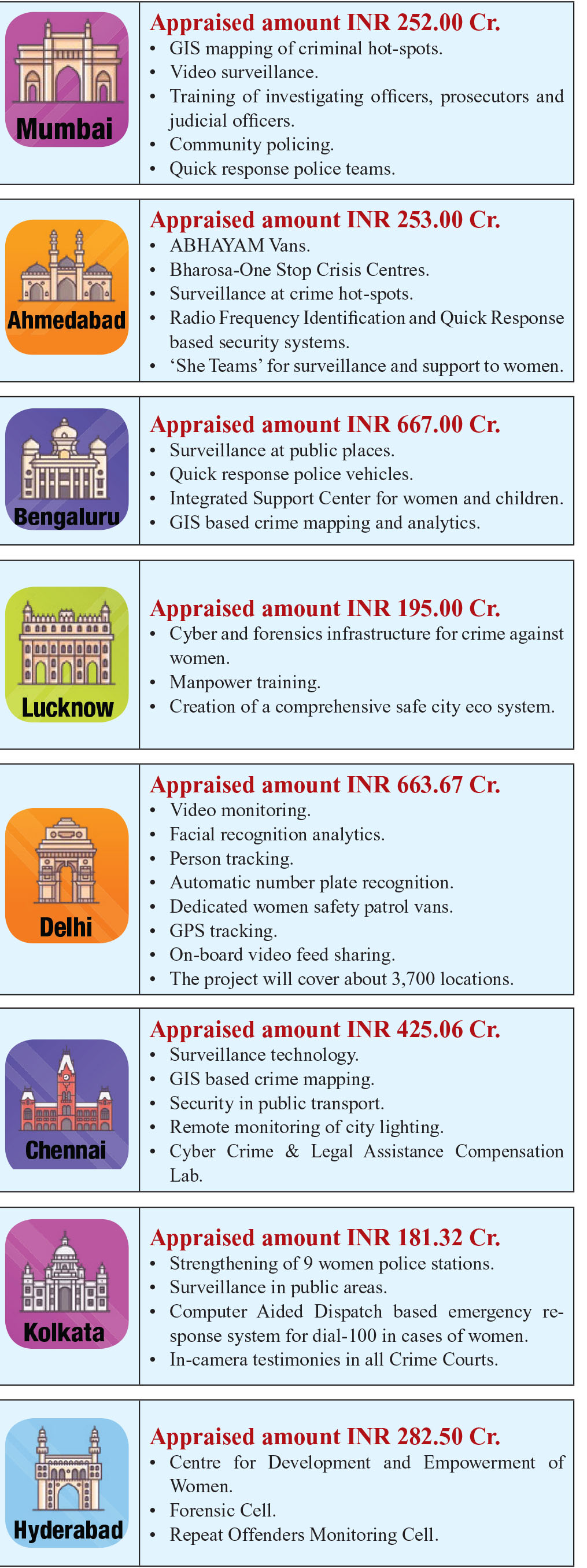 improve the state of digital policing in India.
improve the state of digital policing in India.
The following are the major Nationwide initiatives by the Indian government:
National Intelligence Grid (NATGRID) • Ministry of Home Affairs • Budget Allocated: INR 1002.97 Cr
NATGRID has been developed to leverage IT to connect approved law enforcement agencies with designated data provider in order to enhance India’s counter terrorism capability. An amount of INR 346.05 Cr. has been sanctioned for the construction of NATGRID facilities such as data centers and business continuity planning (BCP), and it is expected that NATGRID will develop the integrated database available to specialized forces of all states.
NIRBHAYA FUND • Ministry of Women and Child Development • Budget Allocated: INR 2,919.55 Cr.
In view of the violence against women and girls which impedes women empowerment by restricting their mobility and is therefore recognized as women rights violation, the Government has set up Nirbhaya Fund. The Fund is aimed to be utilized for projects for women security and safety like surveillance, mapping, street lighting, safer public transport, improved policing etc. Municipal Corporations and Police Commissionerate of the respective cities are working to bring forth a development plan for each city.
The government has chosen 8 major cities namely Mumbai, Ahmedabad, Bengaluru, Lucknow, Delhi, Chennai, Kolkata and Hyderabad for the development of infrastructure and to make the cities safer for women.
DIGITAL POLICE PORTAL • Ministry of Home Affairs • Budget Allocated: The Portal will utilize the budget of CCTNS, since it falls under CCTNS
Digital Police Portal is aimed to act as the national database of crime and criminals, allowing digital public services to the citizens of India, and also assisting in the investigation, policy making, data analytics and research for law enforcement agencies.
Currently, the Portal’s database comprises approximately a crore of data records. The portal provides facility for 11 searched and 46 thematic reports from the national database for state police and central investigation agencies.
EMERGENCY RESPONSE SUPPORT SYSTEM (ERSS) • Ministry of Home Affairs • Budget Allocation: INR 321.69 Cr
The objective of ERSS is to launch pan-India single emergency response number ‘112’ to address various types of distress calls such as police, fire and ambulance etc., by } Advancement of crime & criminal activities is increasing day by day which has led to an imperative need to upgrade the ways of old school policing. Traditional methods of policing are now being replaced by smart policing methods. To decrease the rate of crime and increase the rate of response and investigation, countries around the world have started moving towards the adoption of digital technologies in law enforcement. These introductions of technologies and smart policing will allow the law enforcement agencies to proactively tackle the anti-social elements which are looking to harm the serenity of the society. Technologies such as artificial intelligence, predictive analytics, robotics, facial recognition, intelligent traffic management, information systems and databases, machine learning etc., are being utilized to provide an edge to our current policing solutions. These technologies will help our law enforcement agencies to tackle the crimes & criminals on the frontline as well as in providing swift response to any form of emergencies ~ Uday Kumar Verma Secretary General, ASSOCHAM providing 24/7 response system, which can receive input from voice services, SMS, email, IoT, and panic buttons to attend the citizen in distress. Department of Telecommunications (DoT) has routed all 112 calls to existing Dial 100 in States/ UTs. By using GPS, it aims to enable automated response system for on-time dispatch of field resources by integrating existing Dial 100, Dial 108 and other emergency response systems. It will also include integration with CCTNS, telecom service providers (TSPs) and GMLC (gateway mobile location center)
MHA has released INR 266.63 Cr. so far. Currently the financial assistance to all States and Union Territories is being provided in the form of computer hardware, C-DAC contact center solution along with emergency response (ER) vehicles fitted with GPS/ MDTs. C-DAC has developed mobile application with panic button for citizens, and is currently in the process of setting up emergency response centers (ERCs) in States/ UTs, after which user acceptance testing (UAT) of 112 system will be conducted. Future plans will also include awareness campaigns.
CRIME AND CRIMINAL TRACKING NETWORK & SYSTEMS (CCTNS) • Ministry of Home Affairs • Budget Allocated: INR 2000 Crore
CCTNS is aimed to create a broad and integrated system for improving the efficiency and effectiveness of policing, to adopt principles of e-Governance, and to create nationwide networking infrastructure for ITenabled tracking system. The scope of CCTNS has been expanded to integrate with other criminal justice systems such as courts, prisons, prosecution, forensics and finger prints, and thus, it created a new system called ‘Integrated Criminal Justice System.’ 94.97% of the total 15,353 police stations in States and UTs are now connected to the network, entering all FIRs through CCTNS. Go-live has been initiated in 24 State/ UTs. With 80% of the allocated funds utilized so far, legacy data migration for 91% of the police stations has been completed.
ASSISTANCE TO STATES FOR MODERNISATION OF POLICE • Ministry of Home Affairs Sub-scheme under ‘Modernization of Police Forces (MPF)’ scheme
This is a sub-scheme of the ‘Modernization of Police Forces (MPF)’ scheme which is aimed to fully modernize and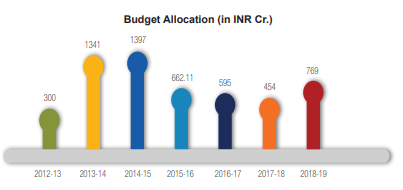 equip state police forces and police infrastructure through the adoption of secure police stations, training centers, mobility for police stations, modern weaponry, communication equipment, forensic set-ups etc.
equip state police forces and police infrastructure through the adoption of secure police stations, training centers, mobility for police stations, modern weaponry, communication equipment, forensic set-ups etc.
So far, in Mumbai, the funds were utilized for installing CCTV network for surveillance, upgraded gear and equipment for police, night vision cameras for covering the coastline and improving the intelligence sharing. In Uttar Pradesh, it is planned to double the capacity of training police constable from its current 5,793 to 11,586 along with constituting a three member commission to provide recommendations for strengthening and modernization of police.
CENTRAL FORENSIC SCIENCE LABORATORIES (CFSL) • Ministry of Home Affairs & CBI • Budget Allocation: Not Available
CFSL is a scientific department that undertakes scientific analysis of crime exhibits referred by CBI, Delhi police, judiciary and vigilance departments of ministries and State/Central Govt. departments. Experts of CBI are made available in six central labs located in Kolkata, Hyderabad, Chandigarh, Bhopal, Pune and Guwahati. However, there exist 23 more forensic labs in the country besides them.
Various new technologies have been installed at CFSLs in India to accelerate the processing and reduce the number of pending cases to minimum which was nearly 1109 till 31 May 2018. For example, an instrument named FRED (Forensic Work Station) has been incorporated in the Cyber Forensic Division of CFSL, and Digital Comparison Microscope has been procured for the use in Ballistics Division of CFSL, New Delhi. Besides, two units of Voice Spectrograph, and Refractive Index Measurement System (GRIM) have been incorporated in the Physics Division.
Shifting gears through emerging technologies
Analytics & Information System
Analytics & Information Systems hold a very vital position in the digital policing world. With India being the second most populated country in the world, law enforcement agencies are always burdened with multiple cases and tons of paperwork which results in delayed response to any situation, and that demands quick actions.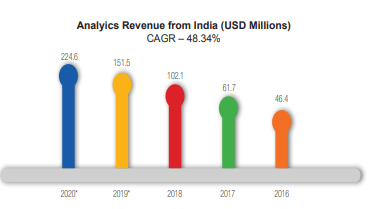
With the onset of new technologies such as big data analytics, artificial intelligence, facial recognition, machine learning etc., India has adopted multiple analytics and information systems to assist the law enforcement agencies in collecting data and creating data repositories which are helpful as databases, and in developing analytical reports. These systems enable law enforcement agencies to act swiftly and perform efficiently to increase public safety and to reduce crime rate across India. These systems not only support the law enforcers, but they also enable the citizens to be a part by providing online availability of multiple services, which involves a law enforcement agency for applications, registration, searches, licensing, amongst various others.
Surveillance & Monitoring
In the modern age of technology, keeping an eye on the elements of the society has become the top priority for the Government of India. Surveillance & monitoring is no longer just for observing; instead, it has grown into the most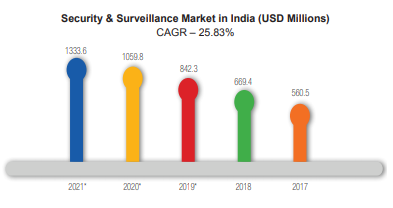 advanced asset in the hands of law enforcement to collect data and information in real time. Multiple initiatives have been launched by multiple police departments to develop networks and to install CCTV cameras along with the assistance from the community which would help develop safer cities and bring down the level of crime.
advanced asset in the hands of law enforcement to collect data and information in real time. Multiple initiatives have been launched by multiple police departments to develop networks and to install CCTV cameras along with the assistance from the community which would help develop safer cities and bring down the level of crime.
(AI), machine language (ML), drones/ UAV (unmanned aerial vehicle) and various others are being integrated into the surveillance network to extract additional useful information from the video and images recorded by the surveillance cameras. It can assist in managing traffic, tracking criminals, identifying suspects and collecting evidence. Government of India has started upgrading and scaling of policing by launching ‘Modernization of Police Forces (MPF)’ scheme and additional initiatives from state departments.
Biometrics
From a tool to devise a national database of citizen identity (Aadhaar Card), biometrics has turned into a security tool for law enforcement agencies. Police has been taking finger prints of criminals for past 125 years; however, digitization of these processes and data has allowed police to uniquely identify criminals and suspects to develop a database of criminals which allows them to keep record of each and every criminal ever caught by the police.
digitization of these processes and data has allowed police to uniquely identify criminals and suspects to develop a database of criminals which allows them to keep record of each and every criminal ever caught by the police.
Biometrics allows the law enforcement agencies to develop and deploy safety solutions which can authentically identify criminals and suspects based on various forms of biometric information received by the sensors. They strategically use a physiological modality, a behavioural modality, or a combination of both. The most common modalities in use are fingerprints, iris and face and voice recognition. State police departments have started integrating biometrics identification technologies like facial recognition in their surveillance network to enhance their policing capabilities.
Research & Development
Evolution of crime demands evolution of policing methods and infrastructure. Governments all around the world are progressing towards digital and smart policing in order to tackle the new world challenges of evolving crime. To do so, they consistently work on integrating latest technologies in policing solutions which gives them an edge over criminals.
The primary focus of research & development in policing is for study of crimes, development, training, integration, and correctional administration.
With these goals in mind, Government of India established the Bureau of Police Research and Development (BPR&D), under the Ministry of Home Affairs in 1970. This initiative was aimed at research & development of multiple frontiers involved in policing, they are:
- To take direct and active interest in the issues,
- To promote a speedy and systematic study of the police problems, and
- To apply science and technology in the methods and techniques used by police
Cybersecurity & Forensics
Crime has been transforming itself to match the technological development happening across the globe. Since the invention of computers and internet, crime has evolved from its physical version to a digital one. Introduction of IT Act in India in 2000, amended in 2008, was the turning point where Government of India started focusing on the digital side of crimes i.e., Cybercrime. 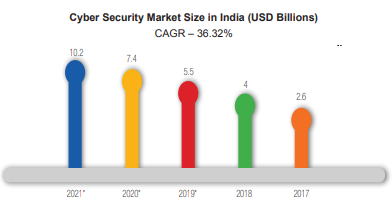
Indian Police has been constantly fighting cybercrime and has taken up multiple initiatives such as cybercrime labs, response centers, cyber forensic labs etc., to do the same. As per the data from Ministry of Home Affairs, in 2016 cybercrimes saw a rise of 457% as compared to the year 2011. To counter it, state government and state police are constantly developing new anti-cybercrime measures with the help of central government and private organizations. Other than these initiatives, training and development of police officers in the field of identifying and solving cybercrimes has been made imperative to keep the police updated about latest criminal activity and the methods required to tackle it.
Public interaction
The most important part of any form of law enforcement is the interaction with the public. Police departments across India are trying to develop new methods of interacting with the public such as online portals, mobile applications, e-kiosks, mobile command centers and many more. Special services for elderly, women and children have been deployed by various state police departments which help them tackle criminals who prey on them.
Public interaction of police has always been a topic of debate. Introduction of technology in this segment will allow the police department to easily register complaints, gather real time intel on situation (Dial100), reduce interaction time (increased response time), and access to remote locations. These public interaction systems will also benefit policemen as they would be free to do the policing work, while the complaint will be registered by the citizens themselves.
Emergency
Emergency response protocols and systems are the backbone of policing in any geography. The primary objective of police department, other than apprehending criminals, is to respond to an emergency in the shortest time possible. For this, they have developed and deployed multiple emergency systems which allow them to shorten the response time and modify their approach with respect to the nature of emergency.
Police departments across India are developing emergency response systems which are specifically designed to assist women and children in need. ‘Women only’ police squads and service helpdesks for the safety of women and children are being deployed in every state to tackle the rising crime against women and children. Other initiatives like Dial 100 is also being implemented pan India (in phases), to strengthen emergency response and increase public safety in crime hotspots.
Training & Development
To tackle the growing challenges in policing and to handle the evolving crimes, police department focuses on training and developing personnel on various protocols, technologies and solutions which are to be used in policing. It forms an important part of the whole policing ecosystem in order to handle different crimes and criminals. Police authorities must be equipped with the latest technologies and know how to turn that technology into an asset for the police department.
In addition to the on & off training conducted by various police departments of each state, there are:
- 5 Central Detective Training Schools (CDTS) located at Chandigarh, Kolkata, Hyderabad, Jaipur and Ghaziabad which are supervised by Bureau of Police Research & Development (BPR&D).
- Established by BPR&D, Central Academy for Police Training (CAPT) at Bhopal to conduct training programs for senior officers (DySSP rank).
- Training Intervention Scheme – BPR&D conducts training programs on various aspects of investigation to train police investigators on specialized areas of investigation (Pan India).
Other than these initiatives, the training division also reviews the training methodology used in these centers, while constantly assessing the future requirements of the police departments for training.
The Impact
Police services are not immune to disruptive changes. Technological, demographical and sociological shifts create megatrends that will reshape the citizens, law enforcement agencies and government. New operating models will leverage to impart essential police services more effectively and new technologies provide significant capabilities to officers at the front end. The introduction of technology into old school policing has not only affected the law enforcement agencies but the government and on a bigger note, the citizens as well.
Citizens
Digital Policing data will help in improving the criminal justice system and outcomes for the public by using criminal justice data. For instance, a number of officers who may be involved in unwanted shooting will be held accountable in the case when they are liable for the offence.
Digital technologies will open up communication channels between citizens and the police force. Social media channels such as Facebook, Twitter and YouTube will dominate as the channel of interaction between citizens and police.
Introduction of smart policing will bring in new methods of reporting crime in contrast to the traditional way of using telephone. Reporting through web portals, mobile applications and social media will lead the way for smart methods of reporting, reducing response time and improving collection of data.
Transparency will drive change for the future. Citizens will be engaged in digital policing initiatives by assisting the police. Everyone will have the right to know what is happening inside their communities in real time, and such transparency will be the driver for a better future.
Law enforcement agencies
Increasing use of body worn cameras and dashboard cameras in patrol cars can record not only officers’ interactions with suspects, victims and the general public, but can also collect and store action and environment details. The cameras would be responsible for providing full transparency into the extremely difficult working of policing.
Data analytics will play an integral role in transforming the way agencies work by uncovering patterns. Officer behavior and wellbeing will be digitally monitored to ensure professional standards, allowing modifications in behavior patterns to resolve problems. Law enforcement agencies will be able to provide predictive analytics to better understand the emerging threats and risks, and thereby warning and alerting citizens.
Digital technologies will allow police services to improve asset utilization, reduced costs and release officers from their stations in order to allow them to spend more time in the community. There will be more number of officers on the street without increasing the number of recruits.
Government
Implementing new policing technologies will enable access to personal information, assisting in the delivery of personalized and better public services. It will help in fighting crime, protecting public security, reducing burden on businesses and citizens, and tackling social exclusion through early intervention.
Rising usage of technology such as artificial intelligence, virtual reality, augmented reality and similar others, will change the job roles of government, along with changing the nature of work currently being done by the officials. There would be a rising need for senior position roles to manage areas such as digital platforms, cybercrimes, and public safety, to name a few.
Analytics platform will be able to provide the right information in real time, helping to support faster and more informed decision making at every level. Audit trail of complete transactions will assist in devising more effective policing and creating strategies for an improve policing.
Recommendations
There is a huge difference in the way policing worked 10 years ago and how it works now. The integration of new technologies in old school policing has uplifted the policing methods and solutions. Taking into account the population and geography of India, implementation of multiple digital policing solutions is a must. The government bodies (central & state) and various law enforcement agencies have already implemented or started implementing various digital or smart policing solution with the help of private organizations in order to fight the rising crime and to provide customized services to different aspects of society.
Owing to the technology trends, crime has evolved itself in order to take advantage of it. From 2011 to 2016, cybercrime incidents skyrocketed by 457% in India only.
Technology integration
Using latest technologies like artificial intelligence, big data analytics, facial recognition, IoT etc., to identify and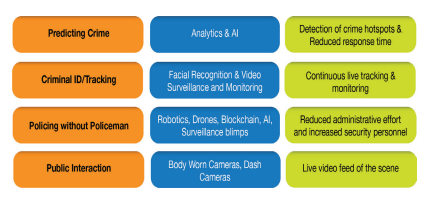 catch suspects/ criminals, has gained much awareness among various law enforcement agencies. However, the implementation of these technologies is not on a national level but on a state level, which makes it very important for the central government to fund and support state-level law enforcement agencies to utilize technologies to upgrade their policing methods.
catch suspects/ criminals, has gained much awareness among various law enforcement agencies. However, the implementation of these technologies is not on a national level but on a state level, which makes it very important for the central government to fund and support state-level law enforcement agencies to utilize technologies to upgrade their policing methods.
Cybercrime
Cyberspace has innumerable entry points which make it hard to tackle its inherent vulnerabilities. Between 2012 to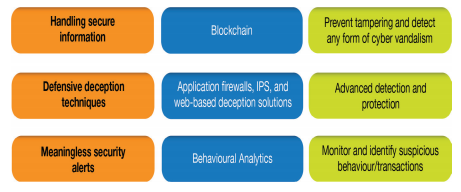 2017, the number of internet users grew at a CAGR of 44% which has led India to be placed 3rd in terms of number of internet users in the world after USA and China. With user growth come increased instances of cybercrime. Symantec Corp ranked India among the top 5 countries to be affected by cybercrimes.
2017, the number of internet users grew at a CAGR of 44% which has led India to be placed 3rd in terms of number of internet users in the world after USA and China. With user growth come increased instances of cybercrime. Symantec Corp ranked India among the top 5 countries to be affected by cybercrimes.
Government of India and multiple law enforcement agencies have taken lead in curbing growing cybercrime. In addition to establishing cyber labs and training the officers, additional development in terms of detecting and resolving cybercrime has to be added in the current arsenal of the law enforcers.
Public awareness & reach
Approximately 69% of India’s population resides in the remote rural areas, thus making it difficult for law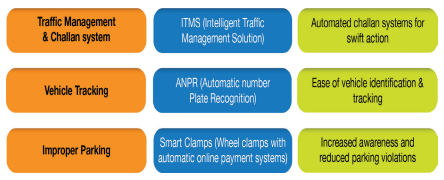 enforcement agencies to provide communication and support in that particular area.
enforcement agencies to provide communication and support in that particular area.
Increasing population and threat of crime require spreading awareness among the citizens and providing them easy access to law enforcement agencies. This will support them in easily reporting incidents, and providing swift response to any problems or crime being faced by them. It will also help in building trust and collaboration between the citizens and the police.
Traffic management
I ndia is the 3rd largest car market in Asia-pacific region. In 2016, there were approximately 230 million registered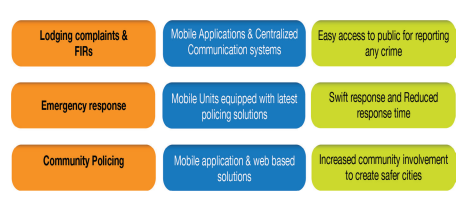 automobiles and 51,300 traffic policemen, that is, 1 policeman for managing 4,484 automobiles. Urban population in India is facing multiple issues like traffic jams, signal jumping, improper parking, over speeding and many others. To curb these issues and to maintain order on road, traffic police departments all around India are introducing multiple solutions like surveillance, traffic sentinel, and community policing via mobile application or web-based reporting, to manage the onroad traffic.
automobiles and 51,300 traffic policemen, that is, 1 policeman for managing 4,484 automobiles. Urban population in India is facing multiple issues like traffic jams, signal jumping, improper parking, over speeding and many others. To curb these issues and to maintain order on road, traffic police departments all around India are introducing multiple solutions like surveillance, traffic sentinel, and community policing via mobile application or web-based reporting, to manage the onroad traffic.
Training & Development
Evolving crime demands upgraded policing solutions. Law enforcement agencies across India need to step up their training and development in order to better equip their officers to handle the evolving crimes. Mobile & web-based applications can help in developing knowledge and information for police officers on the go. Other modern technologies like AR/ VR (augmented reality/ virtual reality) can help train law enforcement officers in subjects and protocols which are otherwise difficult to be done in real life like tactical training, emergency response training, SWAT Training and many others.